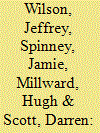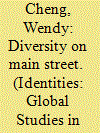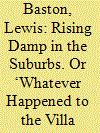|
|
|
Sort Order |
|
|
|
Items / Page
|
|
|
|
|
|
|
| Srl | Item |
| 1 |
ID:
125846


|
|
|
|
|
| Publication |
2013.
|
| Summary/Abstract |
This research investigates whether where we live matters in terms of contributions to direct greenhouse gas (GHG) emissions. Using results from the Halifax Space Time Activity Research (STAR) project, we estimate GHG emissions for 1920 randomly selected respondents in Halifax Regional Municipality, Nova Scotia, Canada. The unique data set allows us to report direct GHG emissions with an unprecedented level of specificity at the sub-regional scale using household energy-use survey data and GPS-verified travel data. We report results and investigate statistical differences between communities and urban-rural zones (inner city, suburban, and inner and outer commuter belts). Results reveal considerable spatial variability in direct GHG emissions across the study area. Our findings indicate that individuals living in the suburbs generate similar amounts of GHG emissions (20.5 kg CO2e person-1 day-1) to those living in the inner city (20.2 kg CO2e person-1 day-1), challenging a widely held assumption that living in the urban centre is better for sustainability. However, individuals in more rural areas have significantly higher transport-related GHG emissions than those living in the inner city and suburbs. Our results underscore the importance of understanding the spatial distribution of GHG emissions at the sub-regional scale.
|
|
|
|
|
|
|
|
|
|
|
|
|
|
|
|
| 2 |
ID:
101038


|
|
|
|
|
| Publication |
2010.
|
| Summary/Abstract |
The emergence in the United States of an increasing number of spaces across the socioeconomic spectrum with majority nonwhite populations merits close attention because of these spaces' potential in reconfiguring historical and contemporary claims to place. In an era in which the neoliberalization of urban development has spurred local governments toward more active involvement in defining relationships between race, ethnicity, consumption, and space, "majority-minority" suburbs are particularly important sites of study. In the late 2000s, two branding campaigns in majority-Asian American and Latina/o municipalities in Los Angeles's San Gabriel Valley-a densely populated region popularly known as a "suburban Chinatown"-put forth specific discourses of race, ethnicity, and culture in attempts to actualize specific visions and claims to place, identity, and history. In doing so, these campaigns illuminated and reinforced larger racial, geographic, and ideological divides. "Diversity" on Main Street embraced pluralist multicultural discourses of the nation, while the "Golden Mile" proposal sought to showcase the transformation of a central thoroughfare by ethnic Chinese capital and immigration. A close examination and comparison of these two campaigns shows how struggles over race, geography, and history are intertwined in the contemporary identities of places and integral to the shaping of civic landscapes.
|
|
|
|
|
|
|
|
|
|
|
|
|
|
|
|
| 3 |
ID:
165559


|
|
|
|
|
| Summary/Abstract |
The suburban areas that were initially stereotyped in the late nineteenth century as ‘Villa Tory’ strongholds and exemplified by Hackney and Islington had, by the 1980s, become ‘bedsitter’ areas dominated by the political left. An examination of the evolution of electoral behaviour in these areas shows that conservatism did indeed dominate the villa suburbs, and that although there were previous intimations of decline, it was not until 1945 that Labour broke the Conservatives’ grip. The causes of this are identified as an outward movement of the population to interwar suburbia, the breaking up of villas into flats, and Labour's increasing appeal to middle class electors. In this category of seats, Labour has outperformed the party's national achievement consistently since 1955; the party's exceptional results here in the 2017 election are, therefore, a new peak on a long‐term trend rather than a breakthrough.
|
|
|
|
|
|
|
|
|
|
|
|
|
|
|
|
|
|
|
|
|